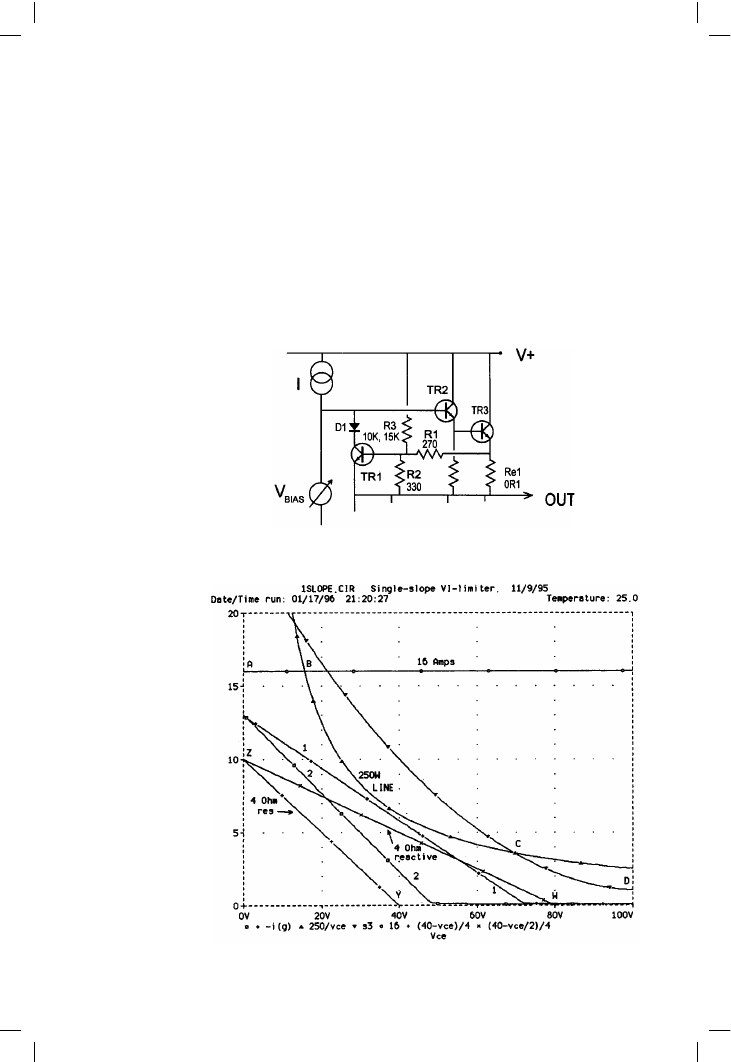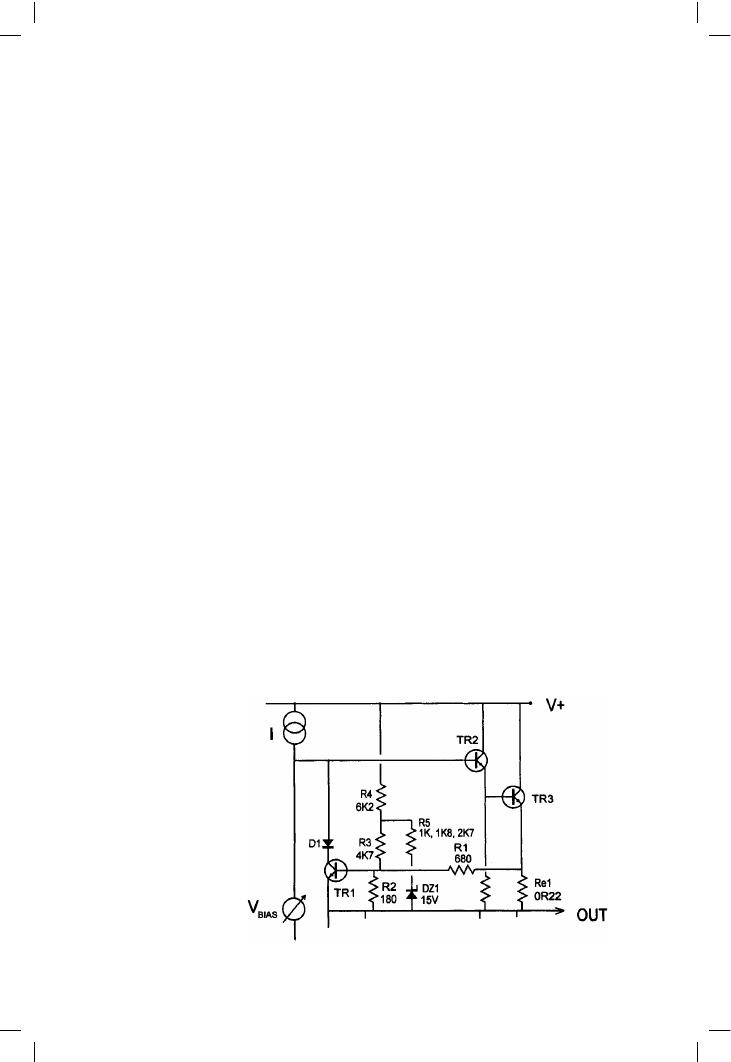ВУЗ: Казахская Национальная Академия Искусств им. Т. Жургенова
Категория: Учебное пособие
Дисциплина: Не указана
Добавлен: 03.02.2019
Просмотров: 17359
Скачиваний: 18

Audio Power Amplifier Design Handbook
Single-slope VI limiting
Simple current-limiting makes very poor use of the device SOA; single-
slope VI limiting is greatly superior because it uses more of the available
information to determine if the output devices are endangered. The Vce as
well as the current is taken into account. The most popular circuit
arrangement is seen in Figure 13.4, where R3 has been added to reduce the
current-limit threshold as Vce increases. This simple summation of voltage
and current seems crude at first sight, but Figure 13.5 shows it to be an
enormous improvement over simply limiting the current.
380
Figure 13.4
Single-slope VI limiter
circuit
Figure 13.5
Single-slope locus
plotted on MJ15024
SOA

Amplifier and loudspeaker protection
The protection locus has now a variable slope, making it much easier to fit
between reactive load lines and the SOA boundary; the slope is set by R3.
In Figure 13.5, Locus 1 is for R3 = 15k, and Locus 2 for 10k. If Locus 2 is
chosen the short-circuit current is reduced to 2 A, while still allowing the
full 4 ! resistive output.
Current capability at Vce = 20 V is increased from 5.5 A to 7.5 A.
Dual-slope VI limiting
The motivation for more complex forms of protection than single-slope VI
limiting is usually the saving of money, by exploiting more of the output
device SOA. In a typical amplifier required to give 165 W into 8 ! and
250 W into 4 ! (assuming realistic losses) the number of device pairs in the
output stage can be reduced from three to two by the use of dual-slope
protection, and the cost saving is significant. The single-slope limiting line
is made dual-slope by introducing a breakpoint in the locus so it is made
of two straight-line sections as in Figure 13.7, allowing it to be moved
closer to the curved SOA limit; the current delivery possible at low device
voltages is further increased.
A dual-slope system is shown in Figure 13.6. The action of the Vce
component on sensing transistor TR1 is reduced when Vce is high enough
for Zener diode DZ1 to conduct. The series combination of R4 and R1 is
chosen to give the required initial slope with low Vce (i.e. the left-hand
slope) but as the voltage increases the Zener conducts and diverts current
through R5, whose value controls the right-hand slope of the protection
locus. Locii 1, 2 and 3 are for R5 = 2k7, 1k8 and 1k respectively.
Current capability at Vce = 20 V is further increased from 7.5 A to 9.5 A.
381
Figure 13.6
Dual-slope VI limiter
circuit

Audio Power Amplifier Design Handbook
Simulating overload protection systems
The calculations for protection circuitry can be time-consuming. Simula-
tion is quicker; Figure 13.8, shows a conceptual model of a dual-slope VI
limiter, which allows the simulated protection locus to be directly
compared with the loadline and the SOA. The amplifier output stage is
reduced to one half (the positive or upper half) by assuming symmetry, and
the combination of the actual output device and the load represented by
382
Figure 13.7
Dual-slope locus
plotted on MJ15024
SOA
Figure 13.8
A conceptual model of
an overload protection
circuit that implements
dual-slope limiting

Amplifier and loudspeaker protection
voltage-controlled current-source G. The output current from controlled-
source G is the same as the output device current in reality, and passes
through current-sense resistor Re1.
The 6 mA current-source I models the current from the previous stage that
TR1 must shunt away from the output device. Usually this is an accurate
model because the VAS collector load will indeed be a current-source. The
feedback loop is closed by making the voltage at the collector of TR1
control the current flowing through G and hence Re1.
In this version of VI-protection the device voltage is sensed by R4 and the
current thus engendered is added to that from R1 at the base of TR1. This
may seem a crude way of approximating a constant power curve, and
indeed it is, but it provides very effective protection for low and medium-
powered amplifiers.
Vin models the positive supply-rail, and exercises the simulation through
the possible output voltage range. In reality the emitter of TR1 and Re1
would be connected to the amplifier output, which would be move up and
down to vary the voltage across the output devices, and hence the voltage
applied across R1, R2. Here it is easier to alter the voltage source V, as the
only part of the circuit connected to HT+. V+ is fixed at a suitable HT
voltage, e.g. +50 V.
The simulation only produces the protection locus, and the other lines
making up the SOA plot are added at the display stage. Ic(max.) is drawn
by plotting a constant to give a horizontal line at 16 A. P(max.) is drawn as
a line of a constant power, by using the equation 250/Vce to give a 250 W
line. In PSpice there seems to be no way to draw a strictly vertical line to
represent Vce(max.), but in the case of the MJ15024 this is 250 V, and is for
most practical purposes off the right-hand end of the graph anyway. The
second-breakdown region is more difficult to show, for in the manu-
facturer’s data the region is shown as bounded by a non-linear curve. The
voltage/current co-ordinates of the boundary were read from manu-
facturer’s data, and approximately modelled by fitting a second order
polynomial. In this case it is:
I = 24.96 – 0.463 . Vce + 0.00224 . Vce
2
Equation 13.2
This is only valid for the portion that extends below the 250 W constant-
power line, at the bottom right of the diagram.
Catching diodes
These are reverse-biased power diodes connected between the supply-rails
and the output of the amplifier, to allow it to absorb transients generated by
fast current-changes into an inductive load. All moving-coil loudspeakers
present an inductive impedance over some frequencies.
383

Audio Power Amplifier Design Handbook
When an amplifier attempts to rapidly change the current flowing in an
inductive load, the inductance can generate voltage spikes that drive the
amplifier output outside its HT rail voltages; in other words, if the HT
voltage is +/–50 V, then the output might be forced by the inductive back-
EMF to 80 V or more, with the likelihood of failure of the reverse-biased
output devices. Catching diodes prevent this by conducting and clamping
the output so it cannot move more than about 1 V outside the HT rails.
These diodes are presumably so-called because they catch the output line
if it attempts to move outside the rails.
Diode current rating should be not less than 2 A, and the PIV 200 V or
greater, and at least twice the sum of the HT rails. I usually specify 400 PIV
3 A diodes, and they never seem to fail.
DC-offset protection
In some respects, any DC-coupled power amplifier is an accident waiting
to happen. If the amplifier suffers a fault that causes its output to sit at a
significant distance away from ground, then a large current is likely to flow
through the loudspeaker system. This may cause damage either by driving
the loudspeaker cones beyond their mechanical limits or by causing
excessive thermal dissipation in the voice-coils, the latter probably being
the most likely. In either case the financial loss is likely to be serious. There
is also a safety issue, in that overheating of voice-coils or crossover
components could presumably cause a fire.
Since most power amplifiers consist of one global feedback loop, there are
many possible component failures that could produce a DC offset at the
output, and in most cases this will result in the output sitting at one of the
HT rail voltages. The only way to save the loudspeaker system from
damage is to remove this DC output as quickly as possible. The DC
protection system must be functionally quite separate from the power
amplifier itself or the same fault may disable both.
There are several possible ways to provide DC protection:
1 By fusing in the output line, the assumption being that a DC fault will
give a sustained current flow that will blow the fuse when music-type
current demands will not.
2 By means of a relay in the output line, which opens when a DC offset is
detected.
3 By triggering a crowbar that shunts the output line to ground, and blows
the HT fuses. The crowbar device is usually a triac, as the direction of
offset to be dealt with is unpredictable.
4 By shutting down the power supply when a DC fault is detected. This can
be done simply by an inhibit input if a switched-mode PSU is used.
Conventional supplies are less easy.
384